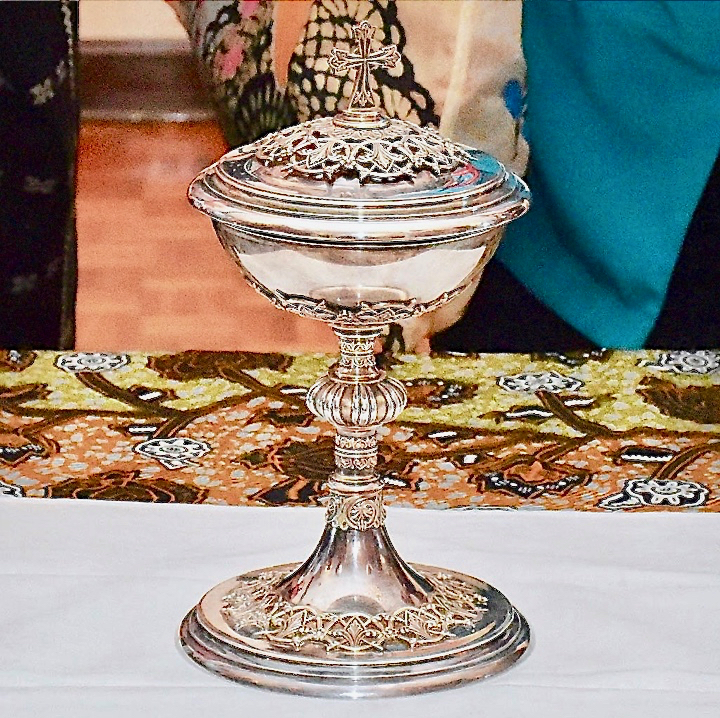Every few years, the USC Province holds a Spirituality Forum that brings together RSCJ, alumnae, Associates, teachers, and friends of the Sacred Heart Family. The 2017 event, with more than three hundred in attendance, was especially important because of the coming bicentennial of the arrival of Philippine and her companions in 1818. At the conclusion of the final Eucharistic celebration on July 15, a surprise was in store for those present. Margot Bremer rscj from Venezuela, in the name of Fernanda Vacas rscj, provincial of Venezuela, presented to Sheila Hammond rscj, provincial, and the whole USC province, a precious treasure: a ciborium that according to oral tradition had been given by Sophie to Philippine in 1818 for the mission in the New World.
Sheila received it with great joy. “This gift … is truly a treasure,” she said. “It was such an honor to receive the ciborium, and to hold it in my hands, knowing it had been held by both Saint Madeleine Sophie and Saint Philippine in the early 1800s.” At the dinner that followed, they telephoned Fernanda, cheered loudly, and sang “I thank my God for you,” as Fernanda listened on the phone in Venezuela.
In a letter to Sister Hammond delivered by Sister Bremer, Sister Vacas wrote that it was time to return the ciborium “to the province where Philippine lived … to celebrate the ‘Woman Who Always Prayed,’ to celebrate friendship, to celebrate frontiers and to celebrate internationality.”
But the ciborium’s route from France to Venezuela is shrouded in mystery. If indeed it was a direct gift from Sophie to Philippine for the new foundation, it left Paris with the five missionaries on February 8, 1818, then sailed to America aboard the Rebecca on March 19. Before they arrived in New Orleans on May 29, they were accosted by pirates near Cuba, but as Philippine wrote, once they learned that the Rebecca was an American ship, the pirates let them go—for unknown reasons, thus saving its contents. Had they ransacked the ship, the ciborium would surely have been taken.
It would then have gone to Saint Charles in 1818, and to Florissant the next year when the community moved back across the Missouri River. It is unlikely that it went with Philippine to the next foundation in Saint Louis, since she wrote soon after arrival there that they could not keep the Blessed Sacrament, since they had no ciborium. That would mean that it stayed in Florissant. Philippine returned to Florissant as superior from 1834 to1840. After that, whether in Saint Louis for a year, then in Sugar Creek with the Potawatomi for one year, then back to Saint Charles for her last ten years, she is highly unlikely to have taken “her” ciborium with her, so it can be supposed that it stayed in Florissant, probably in continuous use, until the house there closed in 1846.
It is possible that at that time, the ciborium was taken to one of the houses in New York, where the Society had been since 1841, because after Saint Philippine’s death in 1852, it seems to have resurfaced in 1858 in New York, from where Mother Mary Ann Aloysia Hardey founded the province of Cuba. Exactly how the ciborium was first used in Cuba is unknown, but it was there for more than one hundred years.
After the Cuban Revolution in 1959, RSCJ stayed in Cuba for two more years before the schools were closed. The last RSCJ left Cuba in May 1961. Most sacristy items were given to local parishes, but the ciborium was kept, because of the memory that it had been given by Sophie to Philippine. Many RSCJ from Cuba went to Puerto Rico, bringing the ciborium with them. The same summer, in July and August, the foundation in Venezuela began. The ciborium was brought to Venezuela and used for liturgy at the Colegio of El Hatillo in Caracas. The RSCJ continued to remember the story of its origin.
When the Society decided to sell the Colegio at El Hatillo in 1974 and cross new frontiers to the barrios of the poorest and most marginalized in the country, Odette Mattos, provincial of Venezuela at the time, said to keep the ciborium, the gift of Sophie to Philippine. It was taken to the community of Coche in Caracas, which had been founded earlier. It remained there and the oral tradition was treasured. Here the idea arose to give it new meaning by returning it to the home of Philippine in this moment of opening new frontiers.
Neither the written accounts of the foundations of Cuba nor of Venezuela mention the ciborium. Its true story remains a mystery in the collective memory of the communities in which it dwelt. It now resides in its new home, the chapel of the provincial offices of the USC province in Saint Louis.
Carolyn Osiek rscj
Archivist
Section |International News
Province |Antilles|United States and Canada|Venezuela

